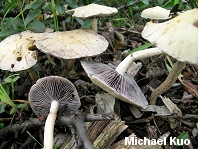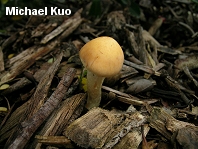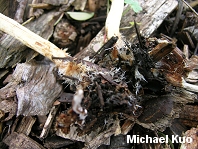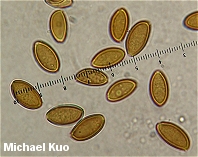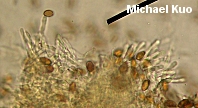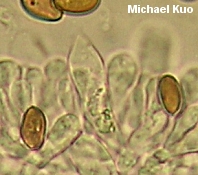| Major Groups > Gilled Mushrooms > Dark-Spored > Stropharioid Mushrooms > Leratiomyces percevalii |

|
Leratiomyces percevalii [ Basidiomycetes > Agaricales > Strophariaceae > Leratiomyces . . . ] by Michael Kuo This woodchip-loving mushroom appears on the West Coast in urban areas; it may be an "import" like the closely related Leratiomyces ceres. It is honey yellow when in the button stage, but soon becomes whitish, yellowish, or dingy olive. It usually has a ring zone of fibers darkened by falling spores, rather than a persistent ring--and its stem base develops reddish brown discolorations. The spore print is deep purple-brown to almost black, helping to separate it from the similar Agrocybe praecox, which also grows in woodchips but features a brown spore print. Microscopic features include prominent cheilocystidia and decidedly non-prominent, hard-to-find chrysocystidia. A competing label for this mushroom is "Stropharia riparia," but I believe that name is misapplied; see the discussion below if you care. Description: Ecology: Saprobic; growing scattered or gregariously in waste places, grassy areas, and woodchips; summer, fall, and winter; West Coast. Cap: 2.5-8 cm; convex, becoming broadly convex or broadly bell-shaped; sticky when fresh but soon dry; honey yellow when young, quickly becoming yellowish, whitish, or dingy olive; smooth or finely hairy in places; the margin adorned with hanging white partial veil remnants, especially when young. Gills: Attached to the stem or beginning run down it; close; whitish at first, becoming purplish gray to purple-black. Stem: 4-13 cm long; up to about 1 cm thick; equal or tapered to base; dry; with a ring zone that darkens with falling spores; finely hairy; whitish, developing reddish brown discolorations from the base upwards; base usually hairy, with prominent mycelial threads. Flesh: Whitish. Odor and Taste: Odor not distinctive, or radish-like; taste similar. Spore Print: Dark purple-brown to blackish. Chemical Reactions: KOH on cap surface yellow. Microscopic Features: Spores 13-16 x 7-9 µ; smooth; more or less elliptical; with a germ pore. Chrysocystidia present on gill faces but inconspicuous (more easily demonstrated in button-stage specimens than in mature specimens, where they are often absent); clavate to irregularly clavate or submucronate; scarcely projecting; to about 50 x 8 µ. Cheilocystidia abundant; to about 70 x 10 µ; clavate to cylindric; flexuous. REFERENCES: (Berkeley & Broome, 1879) Bridge & Spooner, 2008. (Saccardo, 1887; Smith, Smith & Weber, 1979; Smith, 1979; Guzman, 1983; Noordeloos, 1999; Bridge et al., 2008.) Herb. Kuo 01160601. West-Coast collectors often call the mushroom featured here "Stropharia riparia," which is a species named by Alexander Smith (1979). Smith's concept of Stropharia riparia was based on collections made under alders, aspens, and cottonwoods in riparian ecosystems in the Pacific Northwest and the Rocky Mountains. He initially identified the mushrooms (1941) as "Stropharia magnivelaris," but later (1979) named the new species Stropharia riparia in The Michigan Botanist because he wanted
Such emphasis on ecology was rare for Smith, who generally conceived of species as morphological entities. Clearly Smith believed that Stropharia riparia was intimately tied to Populus ecosystems; he even speculated that it was mycorrhizal with aspens and cottonwoods, along with Russula aeruginea and Lactarius controversus. As a morphological species, however, Stropharia riparia differs very little from Leratiomyces percevalii, except in spore dimensions ("11-14[15] x 6-8 µm") and in the putative lack of chrysocystidia ("[p]leurocystidia none"). However, the chrysocystidia of Leratiomyces percevalii are very inconspicuous and are "usually present in young basidiocarps only, disappearing with age, in many mature basidiocarps absent" (Noordeloos, 1999), and thus might have been easily missed if Smith examined only mature specimens. Guzman (1983) examined Smith's riparian collections and identified them as Stropharia percevalii, comparing them directly with material from England (where the species was originally named, based on a collection made in sawdust); he adjusts the spore dimensions of the species to "(11.5-)13-15(-16) x 6.5-8 µm" to account for the Smith material, and lists chrysocystidia as absent. In the absence of better data it seems likely to me that Stropharia riparia should be reduced to synonymy with Leratiomyces percevalii--but I have kept it separated in my key to Stropharia and Leratiomyces to honor the possibility that a distinct species occurs under alders, aspens, and cottonwoods in riparian ecosystems, perhaps characterized morphologically by slightly smaller spores and a lack of chrysocystidia (but thorough study of many collections would be needed to establish these differences). However, the mushroom appearing on the West Coast in woodchips, sawdust, and waste places is in my opinion Leratiomyces percevalii. Leratiomyces magnivelaris is a genetically distinct species (see Bridge and collaborators, 2008) that hardly differs morphologically, except in its more consistent, better developed ring--and a genuine lack of chrysocystidia, even on immature specimens. It is found in urban and woodland waste places, and is apparently boreal and subarctic in distribution. This site contains no information about the edibility or toxicity of mushrooms. |
© MushroomExpert.Com |
|
Cite this page as: Kuo, M. (2009, February). Leratiomyces percevalii. Retrieved from the MushroomExpert.Com Web site: http://www.mushroomexpert.com/leratiomyces_percevalii.html |
